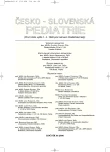Carbon Monoxide as a Marker of Lung Diseases at the Child Age
Authors:
M. Jeseňák 1; E. Babušíková 2; Peter Bánovčin 1
Authors‘ workplace:
Klinika detí a dorastu, Jesseniova lekárska fakulta Univerzity Komenského, Martinská
; fakultná nemocnica, Martin
prednosta prof. MUDr. P. Bánovčin, CSc.
1; Ústav lekárskej biochémie, Jesseniova lekárska fakulta Univerzity Komenského, Martin
prednosta prof. MUDr. D. Dobrota, CSc.
2
Published in:
Čes-slov Pediat 2006; 61 (11): 651-656.
Category:
Comprehensive Report
Overview
Among modern methods included in diagnostic algorithms for various diseases, analyses of expired breath and its condensate acquire increasing importance. Various markers can be determined in the exhaled air, especially volatile gaseous compounds: nitrogen oxide (NO), carbon monoxide (CO), hydrocarbons and 8-isoprostanes. Most of CO in the body originates from the enzyme degradation of heme. Its level in the exhaled air reflects the extent of activation of heme oxygenase, induced by many factors (e. g. cytokines, infections, reactive oxygen and nitrogen species, bacterial toxins). In contrast to NO, CO can serve as a marker of inflammation as well as oxidation stress. The representation of CO in the exhaled breath (eCO) changes in various diseases of the respiratory as well as other systems. The observation of eCO concentrations represents a modern, simple, available and well reproducible method for the diagnosis of many diseases of respiratory system at the child age as well as for observation of progression, severity of the disease and response to therapy.
Key words:
exhaled breath analysis, markers of pulmonary diseases, carbon monoxide, child
Labels
Neonatology Paediatrics General practitioner for children and adolescentsArticle was published in
Czech-Slovak Pediatrics

2006 Issue 11
Most read in this issue
- Glomerulonephritis in Pediatric Practice – Most Frequent Clinical Units, Etiopathogenesis, Therapy and Prognosis
- Louis-Bar Syndrome of Ataxia Telangiectasia in Consanguinous Family
- Juvenile Idiopathic Arthritis from the Very Cruel Side
- Infection of Urinary Pathways in Adolescent Girls
